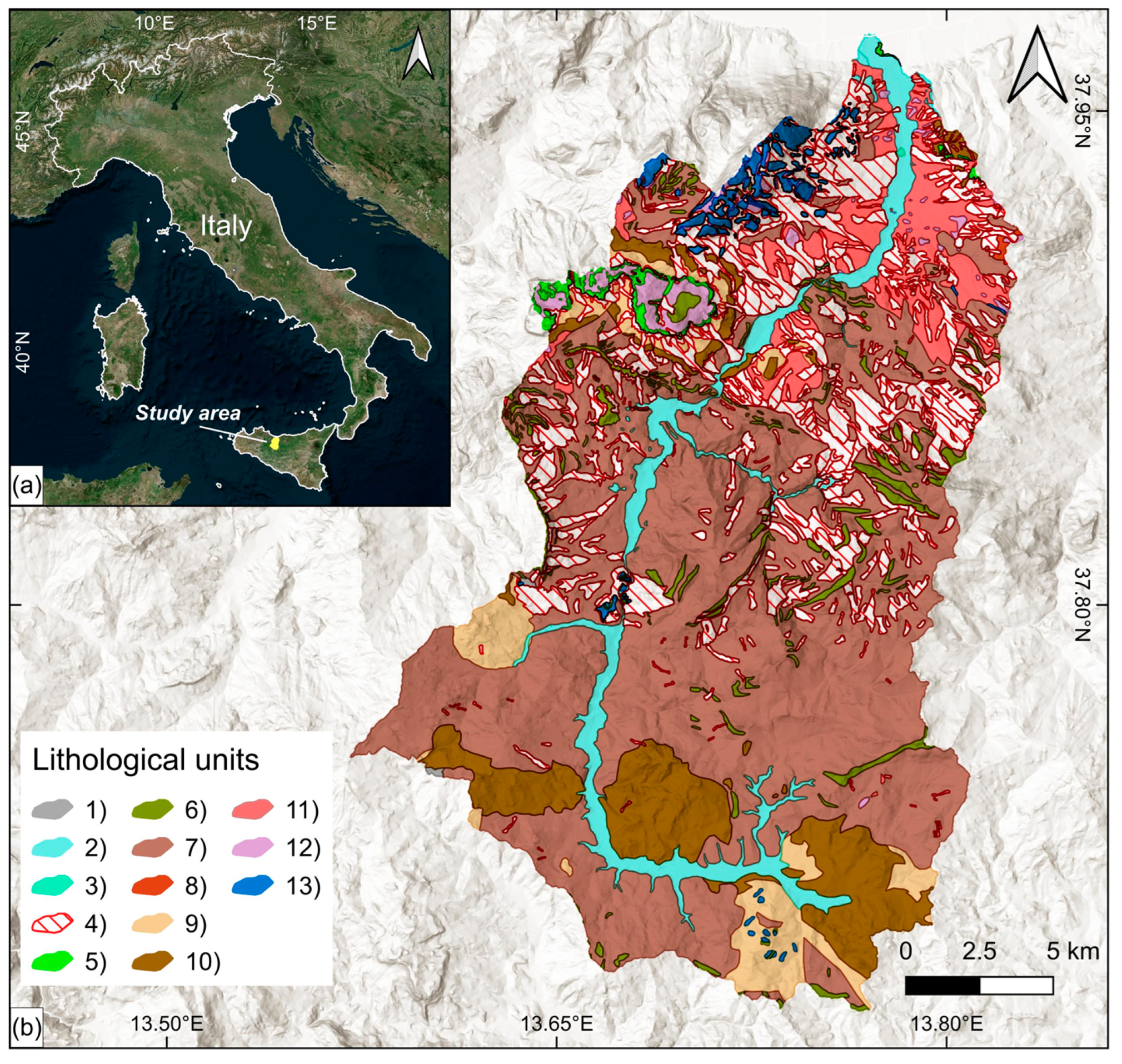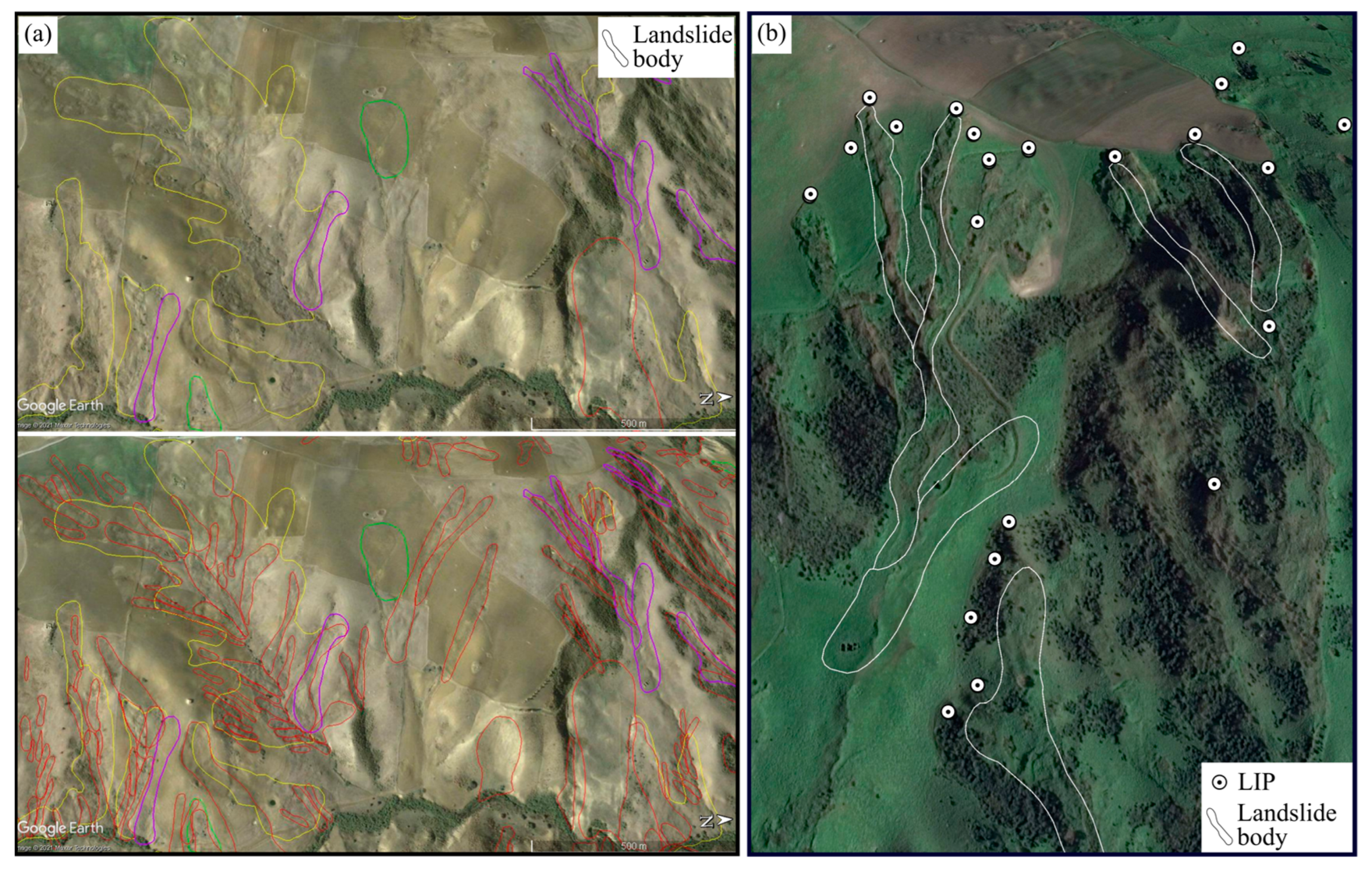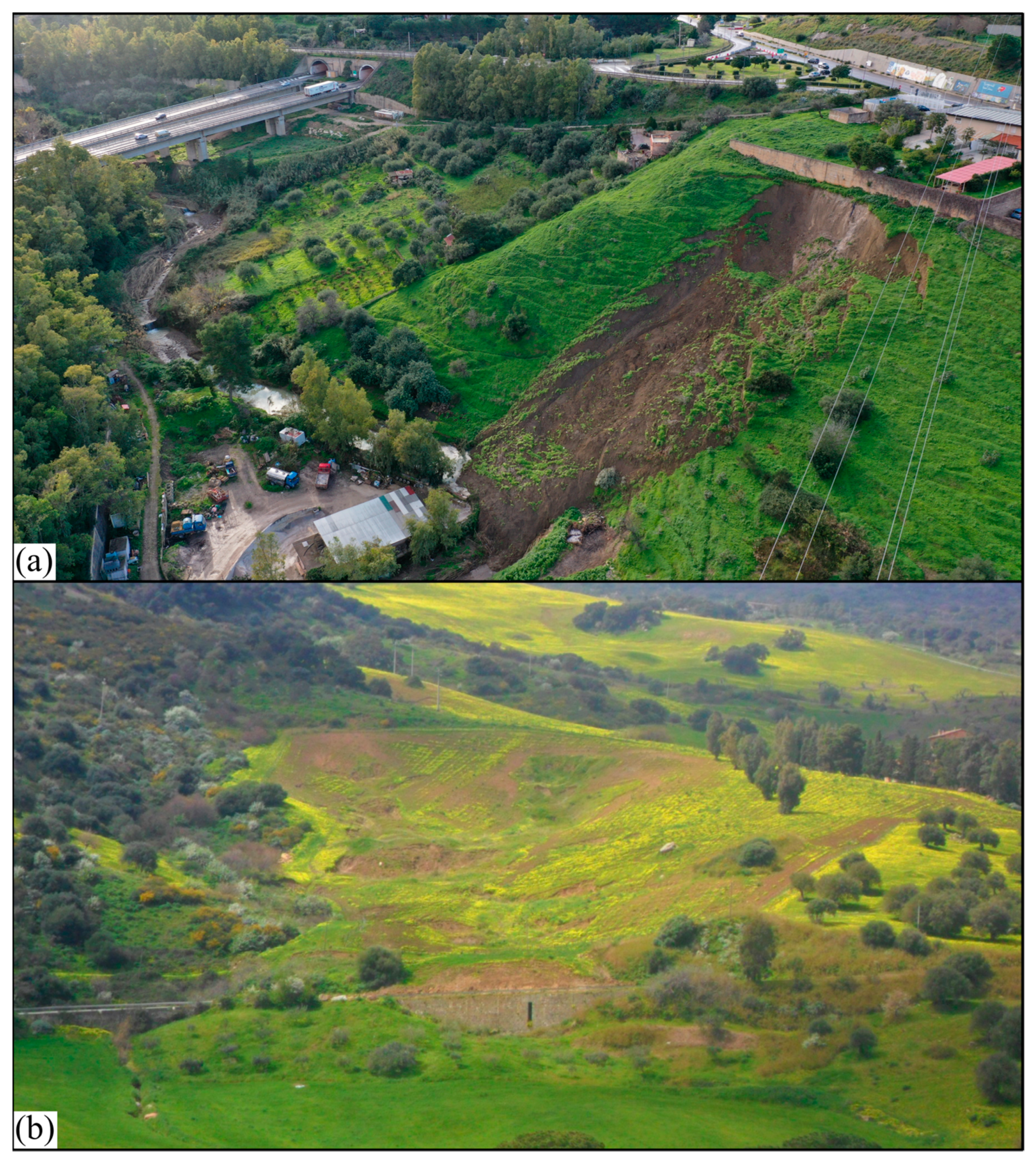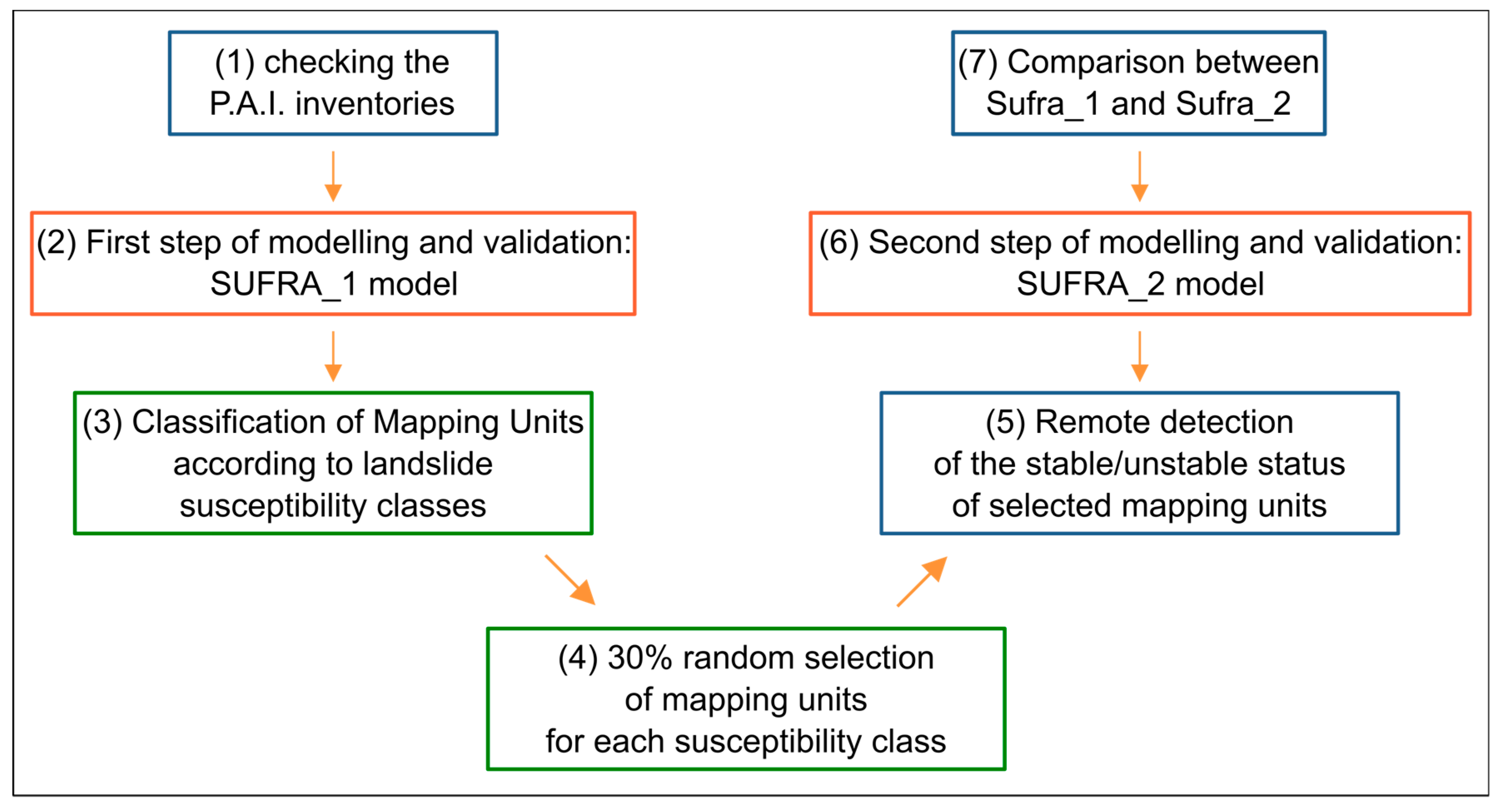Using Public Landslide Inventories for Landslide Susceptibility Assessment at the Basin Scale: Application to the Torto River Basin (Central-Northern Sicily, Italy)
Abstract
:1. Introduction
2. Materials and Methods
2.1. Study Area
2.2. Landslide Inventory
2.3. Mapping Units and Landslide Conditioning Factors
2.4. Statistical Model, Validation Tools, and Model-Building Strategies
3. Results
4. Discussion
5. Conclusions
Author Contributions
Funding
Institutional Review Board Statement
Informed Consent Statement
Data Availability Statement
Acknowledgments
Conflicts of Interest
References
- Carrara, A.; Cardinali, M.; Guzzetti, F.; Reichenbach, P. Gis Technology in Mapping Landslide Hazard. In Geographical Information Systems in Assessing Natural Hazards; Springer: Dordrecht, The Netherlands, 1995; pp. 135–175. [Google Scholar] [CrossRef]
- Crozier, M.J.; Glade, T. A Review of Scale Dependency in Landslide Hazard and Risk Analysis; Wiley: Hoboken, NJ, USA, 2012; ISBN 9780471486633. [Google Scholar]
- Fell, R.; Whitt, G.; Miner, T.; Flentje, P. Guidelines for Landslide Susceptibility, Hazard and Risk Zoning for Land Use Planning. Eng. Geol. 2008, 102, 83–84. [Google Scholar] [CrossRef]
- Brabb, E.E. Innovative Approaches to Landslide Hazard and Risk Mapping. In Proceedings of the 4th International Symposium on Landslides, Toronto, ON, Canada, 16–21 September 1984; pp. 307–324. [Google Scholar]
- Steger, S.; Mair, V.; Kofler, C.; Pittore, M.; Zebisch, M.; Schneiderbauer, S. Correlation Does Not Imply Geomorphic Causation in Data-Driven Landslide Susceptibility Modelling–Benefits of Exploring Landslide Data Collection Effects. Sci. Total Environ. 2021, 776, 145935. [Google Scholar] [CrossRef] [PubMed]
- Martinello, C.; Cappadonia, C.; Conoscenti, C.; Rotigliano, E. Landform Classification: A High-Performing Mapping Unit Partitioning Tool for Landslide Susceptibility Assessment—A Test in the Imera River Basin (Northern Sicily, Italy). Landslides 2022, 19, 539–553. [Google Scholar] [CrossRef]
- Martinello, C.; Mercurio, C.; Cappadonia, C.; Hernández Martínez, M.Á.; Reyes Martínez, M.E.; Rivera Ayala, J.Y.; Conoscenti, C.; Rotigliano, E. Investigating Limits in Exploiting Assembled Landslide Inventories for Calibrating Regional Susceptibility Models: A Test in Volcanic Areas of El Salvador. Appl. Sci. 2022, 12, 6151. [Google Scholar] [CrossRef]
- Harp, E.L.; Keefer, D.K.; Sato, H.P.; Yagi, H. Landslide Inventories: The Essential Part of Seismic Landslide Hazard Analyses. Eng. Geol. 2011, 122, 9–21. [Google Scholar] [CrossRef]
- Lima, P.; Steger, S.; Glade, T. Counteracting Flawed Landslide Data in Statistically Based Landslide Susceptibility Modelling for Very Large Areas: A National-Scale Assessment for Austria. Landslides 2021, 18, 3531–3546. [Google Scholar] [CrossRef]
- Steger, S.; Brenning, A.; Bell, R.; Glade, T. The Influence of Systematically Incomplete Shallow Landslide Inventories on Statistical Susceptibility Models and Suggestions for Improvements. Landslides 2017, 14, 1767–1781. [Google Scholar] [CrossRef]
- Petschko, H.; Bell, R.; Glade, T. Effectiveness of Visually Analyzing LiDAR DTM Derivatives for Earth and Debris Slide Inventory Mapping for Statistical Susceptibility Modeling. Landslides 2016, 13, 857–872. [Google Scholar] [CrossRef]
- Bufalini, M.; Materazzi, M.; De Amicis, M.; Pambianchi, G. From Traditional to Modern ‘Full Coverage’ Geomorphological Mapping: A Study Case in the Chienti River Basin (Marche Region, Central Italy). J. Maps 2021, 17, 17–28. [Google Scholar] [CrossRef]
- Restele, L.O.; Hidayat, A.; Saleh, F.; Iradat Salihin, L.M. Landslide Hazard Assessments and Their Application in Land Management in Kendari, Southeast Sulawesi Province, Indonesia. J. Degrad. Min. Lands Manag. 2023, 10, 4349–4356. [Google Scholar] [CrossRef]
- Martinello, C.; Bufalini, M.; Cappadonia, C.; Rotigliano, E.; Materazzi, M. Combining Multi-Typologies Landslide Susceptibility Maps: A Case Study for the Visso Area (Central Italy). J. Maps 2023, 19, 1–10. [Google Scholar] [CrossRef]
- QGIS Association. QGIS.org QGIS Geographic Information System 2022. Available online: http://www.qgis.org (accessed on 20 August 2023).
- GRASS Development Team Geographic Resources Analysis Support System (GRASS) Software; Version 8.0; Open Source Geospatial Foundation: Chicago, IL, USA, 2022.
- Conrad, O.; Bechtel, B.; Bock, M.; Dietrich, H.; Fischer, E.; Gerlitz, L.; Wehberg, J.; Wichmann, V.; Böhner, J. System for Automated Geoscientific Analyses (SAGA) v. 2.1.4. Geosci. Model Dev. 2015, 8, 1991–2007. [Google Scholar] [CrossRef]
- RStudio Team RStudio: Integrated Development for R. 2020. RStudio: Integrated Development for R. RStudio, PBC, Boston, MA. Available online: http://www.rstudio.com/ (accessed on 20 August 2023).
- Cappadonia, C.; Confuorto, P.; Sepe, C.; Di Martire, D. Preliminary Results of a Geomorphological and DInSAR Characterization of a Recently Identified Deep-Seated Gravitational Slope Deformation in Sicily (Southern Italy). Rend. Online Soc. Geol. Ital. 2019, 49, 149–156. [Google Scholar] [CrossRef]
- Catalano, R.; Avellone, G.; Basilone, L.; Contino, A.; Agate, M. Note Illustrative Della Carta Geologica d’Italia Alla Scala 1: 50.000 Del Foglio 609 “Termini Imerese”, Con Allegata Carta Geologica in Scala 1: 50.000. 2011. Available online: https://www.isprambiente.gov.it/Media/carg/note_illustrative/596_609_CapoPlaia_Termini.pdf (accessed on 20 August 2023).
- Faccenna, C.; Piromallo, C.; Crespo-Blanc, A.; Jolivet, L.; Rossetti, F. Lateral Slab Deformation and the Origin of the Western Mediterranean Arcs. Tectonics 2004, 23, 1–21. [Google Scholar] [CrossRef]
- Parrino, N.; Pepe, F.; Burrato, P.; Dardanelli, G.; Corradino, M.; Pipitone, C.; Morticelli, M.G.; Sulli, A.; Di Maggio, C. Elusive Active Faults in a Low Strain Rate Region (Sicily, Italy): Hints from a Multidisciplinary Land-to-Sea Approach. Tectonophysics 2022, 839, 229520. [Google Scholar] [CrossRef]
- Sulli, A.; Gasparo Morticelli, M.; Agate, M.; Zizzo, E. Active North-Vergent Thrusting in the Northern Sicily Continental Margin in the Frame of the Quaternary Evolution of the Sicilian Collisional System. Tectonophysics 2021, 802, 228717. [Google Scholar] [CrossRef]
- Parrino, N.; Burrato, P.; Sulli, A.; Gasparo Morticelli, M.; Agate, M.; Srivastava, E.; Malik, J.N.; Di Maggio, C. Plio-Quaternary Coastal Landscape Evolution of North-Western Sicily (Italy). J. Maps 2023, 19, 2158889. [Google Scholar] [CrossRef]
- Agnesi, V.; De Cristofaro, D.; Di Maggio, C.; Macaluso, T.; Madonia, G.; Messana, V. Morphotectonic Setting of the Madonie Area (Central Northern Sicily). Mem. Soc. Geol. Ital. 2000, 55, 373–379. [Google Scholar]
- Hungr, O.; Leroueil, S.; Picarelli, L. The Varnes Classification of Landslide Types, an Update. Landslides 2014, 11, 167–194. [Google Scholar] [CrossRef]
- Martinello, C.; Cappadonia, C.; Rotigliano, E. Investigating the Effects of Cell Size in Statistical Landslide Susceptibility Modelling for Different Landslide Typologies: A Test in Central–Northern Sicily. Appl. Sci. 2023, 13, 1145. [Google Scholar] [CrossRef]
- Mokhtari, M.; Abedian, S. Spatial Prediction of Landslide Susceptibility in Taleghan Basin, Iran. Stoch. Environ. Res. Risk Assess. 2019, 33, 1297–1325. [Google Scholar] [CrossRef]
- Nicu, I.C.; Asăndulesei, A. GIS-Based Evaluation of Diagnostic Areas in Landslide Susceptibility Analysis of Bahluieț River Basin (Moldavian Plateau, NE Romania). Are Neolithic Sites in Danger? Geomorphology 2018, 314, 27–41. [Google Scholar] [CrossRef]
- Sameen, M.I.; Pradhan, B.; Bui, D.T.; Alamri, A.M. Systematic Sample Subdividing Strategy for Training Landslide Susceptibility Models. Catena 2020, 187, 104358. [Google Scholar] [CrossRef]
- Erener, A.; Düzgün, H.S.B. Landslide Susceptibility Assessment: What Are the Effects of Mapping Unit and Mapping Method? Environ. Earth Sci. 2012, 66, 859–877. [Google Scholar] [CrossRef]
- Chung, C.-C.; Li, Z.-Y. Rapid Landslide Risk Zoning toward Multi-Slope Units of the Neikuihui Tribe for Preliminary Disaster Management. Nat. Hazards Earth Syst. Sci. 2022, 22, 1777–1794. [Google Scholar] [CrossRef]
- Ehlschlaeger, C. Using the AT Search Algorithm to Develop Hydrologic Models from Digital Elevation Data. In Proceedings of the International Geographic Information System (IGIS) Symposium, Baltimore, MD, USA; 1989; pp. 275–281. [Google Scholar]
- Metz, M.; Mitasova, H.; Harmon, R.S. Efficient Extraction of Drainage Networks from Massive, Radar-Based Elevation Models with Least Cost Path Search. Hydrol. Earth Syst. Sci. 2011, 15, 667–678. [Google Scholar] [CrossRef]
- Mercurio, C.; Martinello, C.; Rotigliano, E.; Argueta-Platero, A.A.; Reyes-Martínez, M.E.; Rivera-Ayala, J.Y.; Conoscenti, C. Mapping Susceptibility to Debris Flows Triggered by Tropical Storms: A Case Study of the San Vicente Volcano Area (El Salvador, CA). Earth 2021, 2, 66–85. [Google Scholar] [CrossRef]
- Naimi, B. Package “Usdm”. Uncertainty Analysis for Species Distribution Models. R-Cran 2017, 18, 1–19. [Google Scholar]
- Guisan, A.; Weiss, S.B.; Weiss, A.D. GLM versus CCA Spatial Modeling of Plant Species Distribution. Plant Ecol. 1999, 143, 107–122. [Google Scholar] [CrossRef]
- Burrough, P.A.; McDonnell, R.A. Principle of Geographic Information Systems; Oxford University Press Inc.: New York, NY, USA, 1998; ISBN 0-19-823366-3. [Google Scholar]
- Wilson, J.P.; Gallant, J.C. Primary Topographic Attributes. In Terrain Analysis: Principles and Applications; Wilson, J.P., Gallant, J.C., Eds.; John Wiley & Sons: Hoboken, NJ, USA, 2000. [Google Scholar]
- Auslander, M.; Nevo, E.; Inbar, M. The Effects of Slope Orientation on Plant Growth, Developmental Instability and Susceptibility to Herbivores. J. Arid Environ. 2003, 55, 405–416. [Google Scholar] [CrossRef]
- Zevenbergen, L.W.; Thorne, C.R. Quantitative Analysis of Land Surface Topography. Earth Surf. Process Landf. 1987, 12, 47–56. [Google Scholar] [CrossRef]
- Ohlmacher, G.C. Plan Curvature and Landslide Probability in Regions Dominated by Earth Flows and Earth Slides. Eng. Geol. 2007, 91, 117–134. [Google Scholar] [CrossRef]
- Beven, K.J.; Kirkby, M.J. A Physically Based, Variable Contributing Area Model of Basin Hydrology. Hydrol. Sci. Bull. 1979, 24, 43–69. [Google Scholar] [CrossRef]
- Florinsky, I.V. Digital Terrain Analysis in Soil Science and Geology; Academic Press: Cambridge, MA, USA, 2012. [Google Scholar]
- Friedman, J.H. Multivariate Adaptive Regression Splines. Ann. Stat. 1991, 19, 1–67. [Google Scholar] [CrossRef]
- Mercurio, C.; Calderón-Cucunuba, L.P.; Argueta-Platero, A.A.; Azzara, G.; Cappadonia, C.; Martinello, C.; Rotigliano, E.; Conoscenti, C. Predicting Earthquake-Induced Landslides by Using a Stochastic Modeling Approach: A Case Study of the 2001 El Salvador Coseismic Landslides. ISPRS Int. J. Geoinf. 2023, 12, 178. [Google Scholar] [CrossRef]
- Felicísimo, Á.M.; Cuartero, A.; Remondo, J.; Quirós, E. Mapping Landslide Susceptibility with Logistic Regression, Multiple Adaptive Regression Splines, Classification and Regression Trees, and Maximum Entropy Methods: A Comparative Study. Landslides 2013, 10, 175–189. [Google Scholar] [CrossRef]
- Mohammed, S.; Jouhra, A.; Enaruvbe, G.O.; Bashir, B.; Barakat, M.; Alsilibe, F.; Cimusa Kulimushi, L.; Alsalman, A.; Szabó, S. Performance Evaluation of Machine Learning Algorithms to Assess Soil Erosion in Mediterranean Farmland: A Case-Study in Syria. Land Degrad Dev. 2023, 34, 2896–2911. [Google Scholar] [CrossRef]
- Tian, M.; Li, L.; Xiong, Z. A Data-Driven Method for Predicting Debris-Flow Runout Zones by Integrating Multivariate Adaptive Regression Splines and Akaike Information Criterion. Bull. Eng. Geol. Environ. 2022, 81, 222. [Google Scholar] [CrossRef]
- Milborrow, S. Notes on the Earth Package. Retrieved Oct. 2014, 31, 2017. [Google Scholar]
- Chung, C.J.F.; Fabbri, A.G. Validation of Spatial Prediction Models for Landslide Hazard Mapping. Nat. Hazards 2003, 30, 451–472. [Google Scholar] [CrossRef]
- Fawcett, T. An Introduction to ROC Analysis. Pattern Recognit. Lett. 2006, 27, 861–874. [Google Scholar] [CrossRef]
- Goodenough, D.J.; Rossmann, K.; Lusted, L.B. Radiographic Applications of Receiver Operating Characteristic (ROC) Curves. Radiology 1974, 110, 89–95. [Google Scholar] [CrossRef]
- Lasko, T.A.; Bhagwat, J.G.; Zou, K.H.; Ohno-Machado, L. The Use of Receiver Operating Characteristic Curves in Biomedical Informatics. J. Biomed. Inform. 2005, 38, 404–415. [Google Scholar] [CrossRef] [PubMed]
- Hosmer, D.W. Lemeshow, Stanley. In Applied Logistic Regression; John Wiley & Sons, Inc.: Hoboken, NJ, USA, 2000; ISBN 0471722146. [Google Scholar]
- Youden, W.J. Index for Rating Diagnostic Tests. Cancer 1950, 3, 32–35. [Google Scholar] [CrossRef] [PubMed]
- Cappadonia, C.; Cafiso, F.; Ferraro, R.; Martinello, C.; Rotigliano, E. Analysis of the Rockfall Phenomena Contributing to the Evolution of a Pocket Beach Area Using Traditional and Remotely Acquired Data (Lo Zingaro Nature Reserve, Southern Italy). Remote Sens. 2023, 15, 1401. [Google Scholar] [CrossRef]
- Jia, Y.; Song, G.; Wang, L.; Jiang, T.; Zhao, J.; Li, Z. Research on Stability Evaluation of Perilous Rock on Soil Slope Based on Natural Vibration Frequency. Appl. Sci. 2023, 13, 2406. [Google Scholar] [CrossRef]
- Cappadonia, C.; Cafiso, F.; Ferraro, R.; Martinello, C.; Rotigliano, E. Rockfall Hazards of Mount Pellegrino Area (Sicily, Southern Italy). J. Maps 2021, 17, 29–39. [Google Scholar] [CrossRef]
- Delchiaro, M.; Della Seta, M.; Martino, S.; Nozaem, R.; Moumeni, M. Tectonic Deformation and Landscape Evolution Inducing Mass Rock Creep Driven Landslides: The Loumar Case-Study (Zagros Fold and Thrust Belt, Iran). Tectonophysics 2023, 846, 229655. [Google Scholar] [CrossRef]
- Rouhi, J.; Delchiaro, M.; Della Seta, M.; Martino, S. New Insights on the Emplacement Kinematics of the Seymareh Landslide (Zagros Mts., Iran) Through a Novel Spatial Statistical Approach. Front. Earth Sci. (Lausanne) 2022, 10, 869391. [Google Scholar] [CrossRef]






| Acronym | Description of Predictor | References | Potential Proxy Significance |
|---|---|---|---|
| ELE | Distribution of elevation | Mean annual rainfall | |
| LCL | Morphological classification of the territory based on the variation in elevation with respect to the neighbouring areas | [37] | Morphological setting |
| SLO | The first derivative of elevation | [38] | Speed of the water and potential underlying rupture surfaces [6,27] |
| N | Cosine of aspect (direction in which the slope degrades more rapidly) | [39] | Seasonal wet/dry cycles of soils [40] |
| E | Sine of aspect (direction in which the slope degrades more rapidly) | [39] | Seasonal wet/dry cycles of soils [40] |
| PLN | The second derivative of elevation, computed along the horizontal plane | [41] | Activation and propagation of landslides [42] |
| PRF | The second derivative of elevation, computed along the direction of the highest slope gradient | [41] | The direction of flow [42] |
| TWI | Calculated as ln[A/tanβ], where A and β, computed on each cell, corresponds to the area of upslope drained cells and the slope gradient, respectively | [43] | Potential infiltration or saturated soil thickness [6,27] |
| SPI | Natural logarithm of the catchment area multiplied by the tangent of the slope gradient | [44] | Proxy of the intensity of surface water erosion [6] |
| LITO | Original geological map | Physical–mechanical properties of rocks [27] | |
| USE | CORINE land cover (2018) | Potential hydrological and surface hydric erosion induced disturbances [27] |
| Positive Cases | Negative Cases | TN | FN | FP | TP | Acc. | Sens. | Spec. | ||
|---|---|---|---|---|---|---|---|---|---|---|
| Torto Area | SUFRA_1 Slide | 45 | 968 | 666 | 0 | 302 | 45 | 0.70 | 1 | 0.69 |
| SUFRA_1 Flow | 78 | 935 | 627 | 1 | 308 | 77 | 0.69 | 0.98 | 0.67 | |
| Sciara Area | SUFRA_1 Slide | 9 | 90 | 70 | 3 | 20 | 6 | 0.77 | 0.67 | 0.78 |
| SUFRA_1 Flow | 7 | 92 | 72 | 3 | 20 | 4 | 0.77 | 0.57 | 0.78 | |
| Positive Cases | Negative Cases | TN | FN | FP | TP | Acc. | Sens. | Spec. | ||
|---|---|---|---|---|---|---|---|---|---|---|
| Torto Area | SUFRA_2 Slide | 85 | 928 | 682 | 0 | 246 | 85 | 0.76 | 1 | 0.73 |
| SUFRA_2 Flow | 122 | 891 | 643 | 6 | 248 | 116 | 0.75 | 0.95 | 0.72 | |
| Sciara Area | SUFRA_2 Slide | 9 | 90 | 67 | 0 | 25 | 9 | 0.77 | 1 | 0.74 |
| SUFRA_2 Flow | 7 | 92 | 74 | 0 | 18 | 7 | 0.82 | 1 | 0.80 | |
Disclaimer/Publisher’s Note: The statements, opinions and data contained in all publications are solely those of the individual author(s) and contributor(s) and not of MDPI and/or the editor(s). MDPI and/or the editor(s) disclaim responsibility for any injury to people or property resulting from any ideas, methods, instructions or products referred to in the content. |
© 2023 by the authors. Licensee MDPI, Basel, Switzerland. This article is an open access article distributed under the terms and conditions of the Creative Commons Attribution (CC BY) license (https://creativecommons.org/licenses/by/4.0/).
Share and Cite
Martinello, C.; Mercurio, C.; Cappadonia, C.; Bellomo, V.; Conte, A.; Mineo, G.; Di Frisco, G.; Azzara, G.; Bufalini, M.; Materazzi, M.; et al. Using Public Landslide Inventories for Landslide Susceptibility Assessment at the Basin Scale: Application to the Torto River Basin (Central-Northern Sicily, Italy). Appl. Sci. 2023, 13, 9449. https://doi.org/10.3390/app13169449
Martinello C, Mercurio C, Cappadonia C, Bellomo V, Conte A, Mineo G, Di Frisco G, Azzara G, Bufalini M, Materazzi M, et al. Using Public Landslide Inventories for Landslide Susceptibility Assessment at the Basin Scale: Application to the Torto River Basin (Central-Northern Sicily, Italy). Applied Sciences. 2023; 13(16):9449. https://doi.org/10.3390/app13169449
Chicago/Turabian StyleMartinello, Chiara, Claudio Mercurio, Chiara Cappadonia, Viviana Bellomo, Andrea Conte, Giampiero Mineo, Giulia Di Frisco, Grazia Azzara, Margherita Bufalini, Marco Materazzi, and et al. 2023. "Using Public Landslide Inventories for Landslide Susceptibility Assessment at the Basin Scale: Application to the Torto River Basin (Central-Northern Sicily, Italy)" Applied Sciences 13, no. 16: 9449. https://doi.org/10.3390/app13169449
APA StyleMartinello, C., Mercurio, C., Cappadonia, C., Bellomo, V., Conte, A., Mineo, G., Di Frisco, G., Azzara, G., Bufalini, M., Materazzi, M., & Rotigliano, E. (2023). Using Public Landslide Inventories for Landslide Susceptibility Assessment at the Basin Scale: Application to the Torto River Basin (Central-Northern Sicily, Italy). Applied Sciences, 13(16), 9449. https://doi.org/10.3390/app13169449










